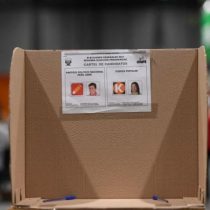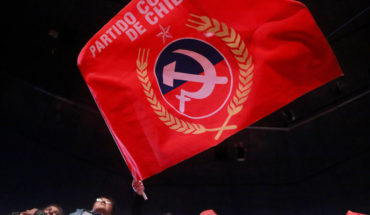
Before the winner of Peru’s presidential election is known, one result has already become clear: the sharp division of the vote between Lima and the north coast, and other regions of the country.
The first percentages that the National Office of Electoral Processes (ONPE) announced on Sunday night already showed quite unequivocally the places that had leaned towards the right-wing Keiko Fujimori, of Fuerza Popular; and the places that had preferred the leftist Pedro Castillo, from Peru Libre.
In general terms, the Andes and the south of the country (red on the map downstairs) voted for Castillo; Lima, the north coast and a part of the jungle, by Fujimori.
This distribution reflects the electoral trends of each area of Peru: the south usually votes for candidates “anti-system”, while Lima and the north coast regions tend to vote for more candidates “conservatives”.
Why this difference?
South “anti-system”
Castillo won in 16 of the country’s 24 regions (red on the map).
In the north and center of the Andes he won in the regions of San Martín, Cajamarca, Amazonas, Huánuco, Pasco and Junín. In addition, he won in Ancash, a region located north of Lima. In the jungle he won in the region of Madre de Dios.
In the southern Andes, a bloc that always tends to vote differently from Lima, Castillo triumphed in Huancavelica, Arequipa, Moquegua, Tacna, Ayacucho, Apurimac, Cusco and Puno.
In Huancavelica, Ayacucho, Apurímac, Cusco and Puno he won with more than 80% of the vote.
“Southern Peru has been voting that way for the last 20 years. It’s a contestant vote, which was announced there 20 years ago, and since before also, but nobody paid attention to it,” Gonzalo Banda, a political analyst in Arequipa, a region of southern Peru, tells BBC Mundo.
Pedro Castillo won in the Andes. IMAGE SOURCE: GETTY IMAGES
In describing how this vote of the Southern Andes is composed, Banda points out that “more than a left-wing vote, it is a vote that brings together several things: it has a vindication and identity, an inclination for candidates with mixed-wing, Andean roots.”
On these factors, Castillo, who is from Cajamarca, an Andean region, “is a candidate who empathizes a lot with the mountain identity, especially in the Peruvian rural highlands,” adds Banda, so the vote for this candidate has “a very strong identity component.”
In addition, in the south “there is a long history of leaders who have always protested against the Lima elites,” according to Banda, also host of the Peruvian podcast “El sur antisistema.”
“Now it is said that [estas regiones] they are ‘anti-system’, but before they made revolutions. Now in recent years there are sporadic social mobilizations, with claims against specific mining projects,” he adds.
Other circumstances that may have favored Castillo in the south is that his rival, Keiko Fujimori, is a “Lima” candidate and has been linked to the political crises of the past five years in Peru, as his party supported the resignation and impeachment of two presidents.
“The south doesn’t like bosses. There is an air of genuine republican rebellion. When all of Peru seems to be forgotten [de las crisis], the south is not forgotten,” says Banda.
In the south (and in other regions of the Andes as well, such as Cajamarca), the vote for Castillo also has an economic component, since this candidate has won in the areas of Peru with greater mining wealth, such as Arequipa.
“What people feel is that [las empresas mineras] they take a lot and leave little,” says Banda.
“One historian told me that maybe the identity of the south is not just an ‘anti-identity’. Perhaps it is also a purposeful identity, in which natural resources are at the service of the community, which includes Andean values. The thing is, it’s not the official identity. It is not Lima, it is not the neoliberal progress of the Constitution of ’93, so its agenda seems very ‘reclamona'”, explains Banda.
The north and the jungle
While Castillo swept some regions of the Andes, Fujimori won in eight regions (yellow on the map): Lima, the capital; Ica, south of this; the northern regions of Tumbes, Piura, Lambayeque, La Libertad, and the jungle regions Ucayali and Loreto.
The vote in Lima – different from the rest of Peru, “in favor of the model” – is an almost stable trend and could be explained because “in Lima there is the conviction that although it is a difficult city, it is a city where there is opportunidades, where if you work you will do well, “says Banda.
In the case of the northern regions, the vote in favour of Keiko Fujimori is explained by the fact that “in the north is still present the image of his father, former President Alberto Fujimori (1990-2000), rolling up his pants and snoothing up to his neck to help people in the El Niño phenomenon (which tends to affect the north coast to a greater extent),” says Banda.
“Fujimori’s memory is not going away.”
Another event that “marked” northern Peru and benefited the figure of Alberto Fujimori in the area, according to the analyst, was the conflict with Ecuador, in which the former president “had an important role” since his government signed peace with the neighboring country in 1998.
The contest between Castillo and Fujimori has been very tight. IMAGE SOURCE: GETTY IMAGES
In addition to these factors, “in the north there are no leaders who answer the Lima elite,” says Banda. “On the other hand, in the south, there were leaders who sometimes made Lima sweat cold.”
The vote in the north and Ica, south of Lima, is also explained by economic factors.
“Ica and the north are agro-industrial export zones, thriving, buoyant. Although there were protests in 2020, there has been an economic boom and employment for almost the entire community. Poverty in Ica and the north has been portentously reduced. Instead, mining [en los Andes] it generates a lot of money, but it employs little labor and few get rich,” says Banda.
The preference of two jungle regions for Fujimori is understood, according to Banda, because “in the jungle there is also the memory of fujimorismo”.
“The memory of the father remains. Fujimori would come to a hamlet and ask ‘what do you need?, a water plant?’ and would appear two weeks later with a water plant.”
Given these explanations, the question remains whether the next government will finally be able to resolve these fractures or whether this fragmentation will continue to manifest itself every time Peruvians go out to vote.





